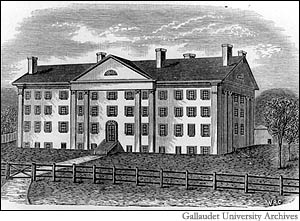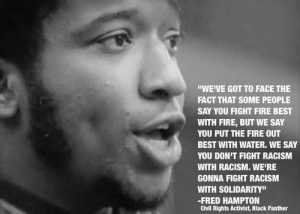During the 1800s, deaf people in America had no language they could use to communicate with other deaf people, or anyone else for that matter. They let others know their needs and wants through gestures and signs they came up with on their own. Some basic gestures, such as “yes” or “hungry,” were somewhat universal, but those signs only scratched the surface of what deaf people wanted to say. They were in need of their own language and of a way and a place to learn it, and although he was not deaf or hard of hearing, a man named Thomas Hopkins Gallaudet was the one who finally acquired it for them.
Thomas Gallaudet was a man of many talents. After graduating from Yale at seventeen, he worked as a law assistant and a tutor, but due to health-related issues, he left his job and became a door-to-door salesman in rural Kentucky and Ohio, where he schooled young children that couldn’t afford an education. He especially enjoyed teaching geography, U.S. history, and the Bible, which eventually lead to him discovering his own passion for religion. He earned his license to be a preacher, and became a traveling minister, going everywhere he felt there was a need. His constant traveling allowed him to visit his family in his hometown of Hartford, Connecticut on a regular basis.1

During one of his visits home, Gallaudet came across his neighbor’s daughter, Alice Cogswell, playing by herself. At the age of two, Alice had contracted meningitis, and as a result, lost her hearing.2 Her father, Dr. Mason Fitch Cogswell, explained to Gallaudet that his daughter was deaf and that she had trouble communicating with not only other children but also with her own family. Knowing that Gallaudet was a teacher, Dr. Cogswell pleaded with Gallaudet to help Alice learn how to speak, regardless of whether it was with her voice or her hands.3
Gallaudet agreed, and started teaching a simple form of sign language as best as he could. Nevertheless, both Gallaudet and Dr. Cogswell were deeply concerned with the lack of deaf education in America and set out to change that. The two them collected donations and support from their community, and soon enough, they had sufficient funds to send Gallaudet to Europe, to track down a sign language teacher.4
During his travels, Gallaudet came across an advertisement for a speech given by Abbe Sicard, the principal of a deaf institution in Paris, France. Gallaudet had previously known about him and his work, so he attended one of his speeches. After the speech, Gallaudet approached Sicard, and spoke to him about his troubles and worries over deaf education in America. Sicard listened intently to his woes and made the decision to invited Gallaudet to the institution he taught at, to take lessons under him. Gallaudet zealously accepted the offer, and went off to Paris with Sicard.5
In addition to taking classes with Sicard, Gallaudet also took private lessons with Sicard’s chief assistant, Laurent Clerc. Gallaudet was entranced by Clerc’s expertise in the sign language and begged him to come to America to teach with him. Clerc was skeptical, but Gallaudet was adamant. He worked hard to get Clerc onboard with his plan. Clerc eventually gave in and sought permission from Sicard to take a leave for his journey to America. Sicard was also initially wary of Clerc’s expedition, but also came around to the idea and granted Clerc the permission he asked for.6

On June 18, 1816, Gallaudet and Clerc set out for Hartford, Connecticut on the ship Mary Augusta, a journey that lasted fifty-two days. The two men used that time to exchange their knowledge of languages. Clerc continued teaching Gallaudet the vast array of signs that were included in French Sign Language, and Gallaudet helped Clerc to polish his English-speaking skills. On August 22, 1816, the day the Mary Augusta arrived in America, Laurent Clerc met Alice Cogswell for the first time. Although she did not know French Sign Language, Clerc “communicated with her through sign associations.” Clerc saw Alice had a strong will to continue to learn sign language, which fueled him in his quest to teach the deaf people of America a standardized nonverbal form of communication.7
Over the next couple of months, Gallaudet and Clerc traveled the United States. They spread information about sign language and deaf culture, met with potential students and their parents, and they began the process of establishing the first deaf school in America. They collected funds by taking donations from the public and from the Connecticut General Assembly also. They raised over $15,000 and they used that money to start what was “originally called the Connecticut Asylum at Hartford for the Instruction of Deaf and Dumb Persons (now the American School for the Deaf).”8 On the day of April 15, 1817, a little less than a year since Gallaudet brought Clerc to the United States, the school opened its doors to the public. Laurent Clerc was the first teacher and Alice Cogswell was the first student. The French Sign Language Clerc taught to his students eventually evolved to the dialect that deaf Americans still use today, American Sign Language.9

Although the school was good, Gallaudet and Clerc wanted to keep going. They went to Congress and got approval from the House of Representatives, Senate, and President Abraham Lincoln to granted college degrees from their school. Eventually, the American School for the Deaf branched out to form Gallaudet University, the first and only all-deaf university in the United States.10 Both the American School for the Deaf and Gallaudet University continue to provide proper education to those who are deaf and hard of hearing, proving a saying that prevails in deaf culture: Deaf people can do EVERYTHING a hearing person can do except hear.
- Katalin Enders, “Gallaudet, Thomas Hopkins,” 2003, Learning to Give (website), https://www.learningtogive.org/resources/gallaudet-thomas-hopkins. ↵
- “Alice Cogswell,” Scholastic. April/May 2012. ↵
- Carolyn Ball, The History of American Sign Language Interpreting Education (Minnesota: Capella University, 2007), 11. ↵
- Loida R. Canlas, “Laurent Clerc: Apostle to the Deaf People of the New World,” 2015, Gallaudet (website), http://www3.gallaudet.edu/clerc-center/info-to-go/deaf-culture/laurent-clerc.html. ↵
- Margret A. Winzer, The History of Special Education: From Isolation to Integration (Washington D.C.: Gallaudet University Press, 1993), 101. ↵
- Margret A. Winzer, The History of Special Education: From Isolation to Integration (Washington D.C.: Gallaudet University Press, 1993), 101. ↵
- Loida R. Canlas, “Laurent Clerc: Apostle to the Deaf People of the New World,” 2015, Gallaudet (website), http://www3.gallaudet.edu/clerc-center/info-to-go/deaf-culture/laurent-clerc.html. ↵
- Loida R. Canlas, “Laurent Clerc: Apostle to the Deaf People of the New World,” 2015, Gallaudet (website), http://www3.gallaudet.edu/clerc-center/info-to-go/deaf-culture/laurent-clerc.html. ↵
- Marc Marschark and Patricia E. Spencer, Oxford Handbook of Deaf Studies, Language, and Education (Oxford: Oxford University Press, 2003), 13-14. ↵
- Loida R. Canlas, “Laurent Clerc: Apostle to the Deaf People of the New World,” 2015, Gallaudet (website), http://www3.gallaudet.edu/clerc-center/info-to-go/deaf-culture/laurent-clerc.html. ↵



61 comments
Bianca Villarreal
It was really nice to know an article has been done over the origins of American Sign Language. I took ASL in high school all four years, and I enjoyed every minute of it. I met so many people that I’m still friends with and because my high school is known for having the biggest deaf student program in the city, I was able to meet a lot of Deaf people through the Deaf socials we have. I learned so much other than the language itself; things like the culture, history, Martha’s Vineyard, and the difference between little d deaf and big D deaf. I hope more people get to learn about Sign Language and it’s origins and hopefully the language too.
Javier Camacho
I remember being younger and seeing snippets of an animated show or short about Gallaudet, but I do not remember what it was called. But I do have a very high appreciation for ASL due to the fact that my sister is disabled and is beginning to learn ASL at a very young age. I think it is very amazing how ASL stemmed from overseas and became such a huge part of our society being that it is the language of very many other people in the world.
Ilse Amaya
I find this article very informative, it gave me some knowledge about sign language that I didn’t have before. I liked learning the origin of ASL, and personally, I have always wanted to learn a little bit of sign language. Furthermore, I never thought of how life was for the people who did not have the opportunity to communicate before sign language was officially taught. It is impressive how we have evolved and advanced as a society. Also, it is important to be informed about this because events like this only happen once, and change the world for the better.
Gabriel Lopez
I remember watching a cartoon about Gallaudet when I was little. I couldn’t quite remember his name until now, but it was a pleasure reading about him here. Unfortunately, I can’t find the film that I watched, but I remember watching him that he helped a boy that struggled to read lips and formed a bond with Gallaudet. Aside from that, it truly is inspirational that Gallaudet was able to help provide an education for deaf people. Thank you for sharing this article.
Madelynn Salinas
Never in my life have I ever though about where sign language originated from, until reading about Thomas Gallaudet and I think that is an example itself on how easily this community can be ignored. This opened up my mind to understanding that remedies and methods for tackling any health care issue, did not come out of the blue. It took time, and persistence from a single mind, and like minds to develop the technology we have today, including the sign language. More specifically it is the environment that surrounds you that leads to these groundbreaking advances that have helped so many people to this day, and that will foster more advances and help even more people.
Elizabeth Guardiola
I have always had an appreciation for American Sign Language and was thrilled to stumble upon an article about it’s origin. The dedication of Thomas Gallaudet to help deaf Americans learn a form of communication is absolutely admirable, especially now knowing the lengths he went to. It is amazing to see what American Sign Language has evolved into in today’s contemporary society. I believe it is thanks to ASL that deaf people are now part of a greater community with a rich culture.
Trinity Casillas
It’s neat to see that Gallaudet sought out on this journey despite not originally having a deep connection to Alice, like a blood relationship. It’s also cool to see that Gallaudet and Clerc went the extra mile by not only opening a school for the deaf but also opening up an institution for higher education for them. The ending quote also made me smile because when I was younger I had a lot of trouble with my hearing, and I still do have some minor issues today, so I did struggle a little bit with learning. Small quotes and positive attitudes like those would’ve made me more encouraged when I was younger.
Julia Patrick
Before reading this article, I had never really thought about when sign language originated, or when the first school for the deaf was founded. I think it’s important that we know of things like this in history because of how far we’ve come. Learning ASL is something I’ve been wanting to do for a while now and after reading this it just encourages me more to look into classes for it. I don’t think we as a society ever really think about all the work that goes into learning this language and everything that comes with it. I love reading articles like this because it’s so interesting and it’s heartwarming in a way to hear stories of people coming together to improve the quality of life for others.
Isabella Torres
This was the first time I’ve ever really heard where sign language truly came from; I didn’t realize that it wasn’t developed until the 1800s. In recent years I’ve been able to work with some kids who were partially deaf and used sign language to communicate. Although I don’t sign, I would love to be able to learn it one day so I’m able to communicate with those who are deaf. If sign language was never created, I wonder how different both education and society would be for deaf people. The sheer persistence and desire to help others displayed by Gallaudet and Sicard have greatly changed the world and created many opportunities for those who use ASL.
Brianna Ramos
Once upon a time, I was a Speech Pathology and Audiology major and wanted to desperately be an American Sign Language interpreter. With that, I later took Survey of Deaf Culture and we learned about Thomas Gallaudet and the university named after him. Thomas recognized that the Deaf community were lacking communication and education, with his efforts he later helped form the opportunities that are available today. It was a very informative article, much of the information I learned previously in my old classes, but it was detailed and interesting. One thing I will say is that “Deaf” should be capitalized when referring to members of the community and lower case when it is referring to hearing loss.